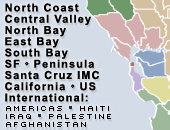From the Open-Publishing Calendar
From the Open-Publishing Newswire
Indybay Feature
Why Plan Mexico will Crash and Burn
Rampant corruption on both sides of the border exacerbate the ineffectiveness of an already failed strategy
Plan Mexico, the US military and police aid package to the Mexican government, is based on a failed “war on drugs” model. This model prioritizes criminalizing the drug trade at the expense of focusing on the harmful effects of drug abuse and addiction as a public health problem. The result has been a blood-soaked disaster.
The War at Home
The United States’ war on drugs kicked into high gear beginning with the Nixon administration in the 1970s. President Nixon increased the federal resources dedicated to prosecuting drug crimes and increased penalties for drug dealers. The Reagan administration followed suit and increased penalties for drug users, especially crack users. The first Bush administration continued the march to war by appointing Bill Bennett as drug czar. Rolling Stone’s Ben Wallace-Wells reports that Bennett once commented: “Two words sum up my entire approach: consequences and confrontation.”
Decades of drug war policy decisions were made based on rhetoric, not hard data. A 2001 report from the National Research Council on the drug war concluded, “The existing drug-use monitoring systems are strikingly inadequate to support the full range of policy decisions that the nation must make.... It is unconscionable for this country to continue to carry out a public policy of this magnitude and cost without any way of knowing whether and to what extent it is having the desired effect."
After decades and hundreds of billions of dollars spent on get-tough drug policies, the war on drugs’ collateral damage is painfully evident. The Drug Policy Alliance Network (DPAN) states that approximately 1.5 billion people are arrested each year in the United States for drug law violations, making the US the biggest jailer in the world—at the expense of US taxpayers. Even the chronically ill are fair game in the war on drugs: the Supreme Court ruled in 2005 that the federal government can prosecute medical marijuana patients, even in states where medical marijuana is legal. And the drug war is making US residents even sicker: because the federal government refuses to fund needle exchange programs, intravenous drug users are at high risk for hepatitis and HIV infection. Thirty-four percent of all reported new HIV infections are amongst intravenous drug users, with 75% of reported new HIV infections amongst women and children being in some way related to intravenous drug use. Needle exchange programs, while painfully under-funded and stymied by some states’ laws against the possession, distribution, and sale of syringes, are scientifically proven to lower infection rates.
More
The War at Home
The United States’ war on drugs kicked into high gear beginning with the Nixon administration in the 1970s. President Nixon increased the federal resources dedicated to prosecuting drug crimes and increased penalties for drug dealers. The Reagan administration followed suit and increased penalties for drug users, especially crack users. The first Bush administration continued the march to war by appointing Bill Bennett as drug czar. Rolling Stone’s Ben Wallace-Wells reports that Bennett once commented: “Two words sum up my entire approach: consequences and confrontation.”
Decades of drug war policy decisions were made based on rhetoric, not hard data. A 2001 report from the National Research Council on the drug war concluded, “The existing drug-use monitoring systems are strikingly inadequate to support the full range of policy decisions that the nation must make.... It is unconscionable for this country to continue to carry out a public policy of this magnitude and cost without any way of knowing whether and to what extent it is having the desired effect."
After decades and hundreds of billions of dollars spent on get-tough drug policies, the war on drugs’ collateral damage is painfully evident. The Drug Policy Alliance Network (DPAN) states that approximately 1.5 billion people are arrested each year in the United States for drug law violations, making the US the biggest jailer in the world—at the expense of US taxpayers. Even the chronically ill are fair game in the war on drugs: the Supreme Court ruled in 2005 that the federal government can prosecute medical marijuana patients, even in states where medical marijuana is legal. And the drug war is making US residents even sicker: because the federal government refuses to fund needle exchange programs, intravenous drug users are at high risk for hepatitis and HIV infection. Thirty-four percent of all reported new HIV infections are amongst intravenous drug users, with 75% of reported new HIV infections amongst women and children being in some way related to intravenous drug use. Needle exchange programs, while painfully under-funded and stymied by some states’ laws against the possession, distribution, and sale of syringes, are scientifically proven to lower infection rates.
More
For more information:
http://narcosphere.narconews.com/notebook/...
Add Your Comments
We are 100% volunteer and depend on your participation to sustain our efforts!
Get Involved
If you'd like to help with maintaining or developing the website, contact us.
Publish
Publish your stories and upcoming events on Indybay.
Topics
More
Search Indybay's Archives
Advanced Search
►
▼
IMC Network


